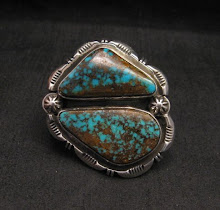When the
price of sterling silver hit almost $50 an ounce this past year, well known silversmith Johnathan Nez began using copper instead of
sterling silver in some of his popular bracelets. The results are strikingly beautiful! Johnathan was just one of a number of Native American silversmiths who began fashioning their usual turquoise jewelry out of copper instead of sterling silver. The trend was born out of necessity. More and more artists were having difficulty affording the silver they needed to make their jewelry.
The
tradition of using copper in jewelry began many years ago for the
Native Americans. Before the Europeans came to America, native
metalwork was fairly simple, consisting primarily of hammering and
etching copper into pendants or earrings and fashioning copper and
silver into beads. It wasn't until the Navajo, Hopi and Pueblo artists
learned silversmithing from the Spanish in the 1800's, that the use of
silver in metal jewelry arts blossomed in the Southwest.
 |
During the Fred Harvey era, when there was a big demand for inexpensive tourist trinkets and jewelry, copper was often used in place of silver. For example, the Bell Trading Post, founded in 1935 by Jack Michelson in Albuquerque, New Mexico, produced tourist/Fred Harvey era pieces made by Native Americans. The majority of jewelry made was made from sterling silver, turquoise and copper.
In the 1940's when Hopi silversmiths Fred Kabotie and Paul Saufkie started the G.I. training program for Hopi veterans to learn silversmithing, students worked with copper for practice because it was less expensive and even produced a few pieces for sale. Today many young aspiring silversmiths begin their jewelry making careers using copper until they master their jewelry making skills.
Often a protective coating has been applied to the copper jewelry to help prevent tarnishing.
Some other interesting facts about copper:
Copper jewelry has been worn for thousands of years for relief of the pain of arthritis and rheumatic diseases. Copper has been used for medicinal purposes as far back as ancient Egypt, Greece and Rome as well as in the ancient Aztec civilization.











No comments:
Post a Comment